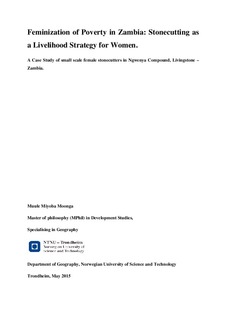| dc.description.abstract | The impacts of structural adjustment programs, declines in public and private employment, modified patterns of trading and farming have all drawn women away from their more traditional roles in subsistence agriculture, and toward more wage-dependent types of informal employment in Zambia. Stone chip production has therefore become a major livelihood strategy for vulnerable and poor women in several localities in the peri-urban fringes of Livingstone District in Zambia. The increased demand for construction materials for housing and road networks in the District has increased the demand for stone chips making stonecutting a lucrative business in Ngwenya compound.
As these women in Ngwenya have entered the cash economy, however, they have become more marginalised and at the same time, many are becoming household heads mainly due to the HIV/AIDS pandemic in Africa. Women are thus more susceptible to poverty than men and this research study sought to find out why these women engage in illegal small scale stone extraction instead of indulging in any other income generating businesses. The rationality that women in Ngwenya compound experience poverty incomparably more than men can therefore be argued as the background against which the feminization of poverty takes place and is therefore an appropriate analytical lens for the study. With the use of feminist qualitative methodological tools and techniques, the research also endeavours to identify the main gendered and non-gendered barriers and constraints inhibiting women from fully participating in small scale quarrying activities to increase their livelihood, especially those providing for their families and whom children are solely dependent. Because the study explores the different livelihood outcomes realized by women as a result of stonecutting activities, the study took on a case study approach which relied on a female perspective to gain information qualitatively through individual and group interviews, personal observations and the uses of documented data from published and unpublished archived sources. Choice of use of this method was because of its flexibility and adaptability to local cultural social contexts and conditions and its ability to generate rich, in-depth data.
As female stonecutters producing chipped stones, the study found that choice of this livelihood strategy inhibits women from gaining other experiences through other activities which places them at a disadvantage within the increasingly commercialised economy. This is because while this stone cutting business is generating income and has the potential to provide viable livelihood outcomes for hundreds of women in Ngwenya compound, plenty existing barriers and constraints inhibit women from participating fully and making this livelihood strategy successful. The multitude of problems (both cause and effect) associated with stone cutting activities such as income fluctuations as their business is market driven, the physical hardships and health problems that affect them all result in reduced livelihoods
outcomes for these women engaged in stone chip production. | nb_NO |
